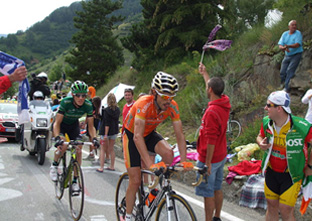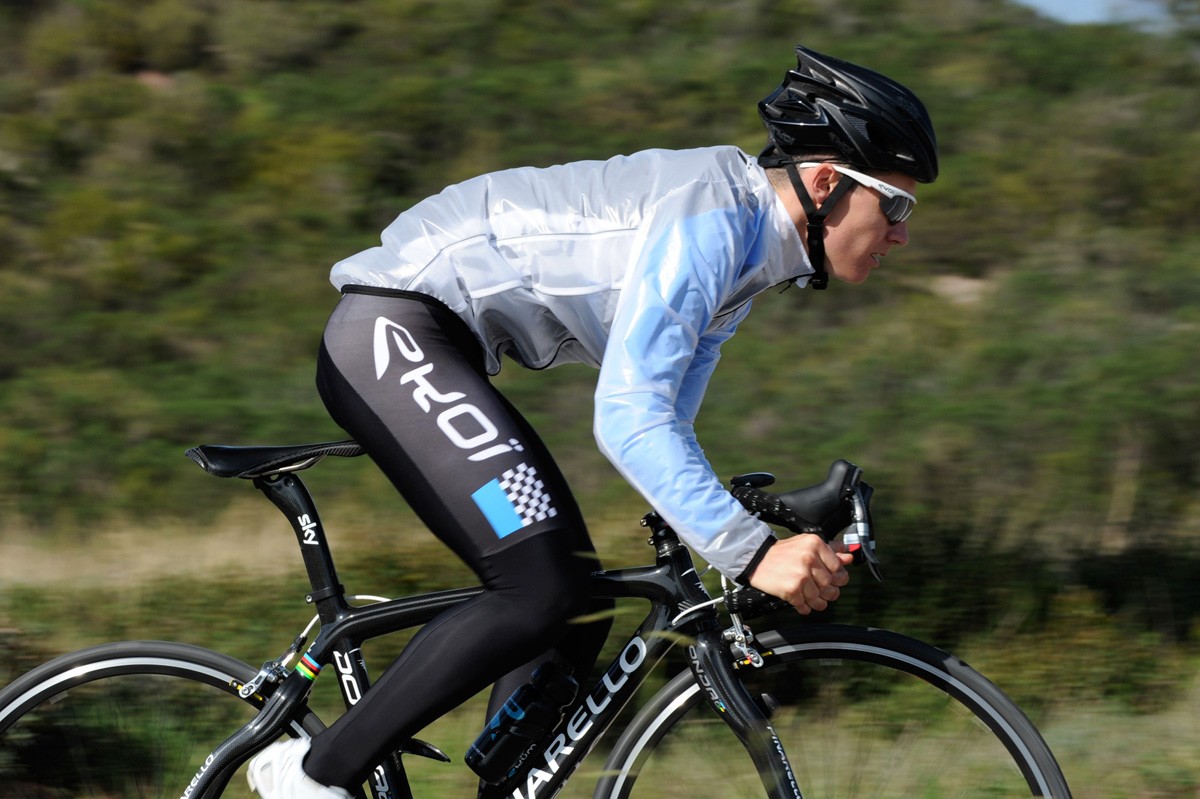
Polymers from head to toe
All-weather protection
Let's face it - it's been years since even a single gram of a cyclist's competition attire could be called natural. There is not a single manufacturer whose catalogue offers anything other than materials made from synthetic fibres. They have become indispensable in the design of so-called technical clothing due to their functional properties: durability, chemical resistance, permeability or impermeability, thermal properties, elasticity, etc. These clothes are so comfortable that one could almost forget how difficult a sport cycling truly is. These modern materials perfectly fit the shape of the body and provide significant gains in terms of aerodynamics, regardless of the cyclist's posture. Even better, they wick away perspiration while keeping the athlete warm.

For a few tenths of a second
 Even though these clothes are not yet tested in wind tunnels, they nevertheless have an important part to play in aerodynamics. Many team managers have been known to get angry when one of their cyclists opens up their jersey on a hot day, flying in the face of the rules of aerodynamics. It is an understandable but unnecessary reflex given that the fibres are fully breathable and allow the evacuation of sweat. There is not too much cause for concern, though, because the cyclists' times are still calculated in seconds or even minutes. Pushing things even farther, some brands offer seamless clothes whose parts are glued together in order to prevent micro-vortex effects.
Even though these clothes are not yet tested in wind tunnels, they nevertheless have an important part to play in aerodynamics. Many team managers have been known to get angry when one of their cyclists opens up their jersey on a hot day, flying in the face of the rules of aerodynamics. It is an understandable but unnecessary reflex given that the fibres are fully breathable and allow the evacuation of sweat. There is not too much cause for concern, though, because the cyclists' times are still calculated in seconds or even minutes. Pushing things even farther, some brands offer seamless clothes whose parts are glued together in order to prevent micro-vortex effects.
A full suitcase
 iThat being said, a cyclist's attire is composed of many pieces: shorts, jersey, gloves, jacket, etc. In this case, polyesters, elastanes and other polyamides have the lion's share of the market. The materials are flexible enough to perfectly adhere to the skin without interfering with movement. The jackets are even trimmed with silicone bands to better fit the jersey and therefore not lift up in the wind. Some brands offer clothing coated with a thin layer of a silicone-based polymer in order to make them water repellent, a particularly important detail in times of rainy weather when the item of clothing is likely to soak up water and thus increase in weight. Of course, the textile's breathable qualities are perfectly preserved.
iThat being said, a cyclist's attire is composed of many pieces: shorts, jersey, gloves, jacket, etc. In this case, polyesters, elastanes and other polyamides have the lion's share of the market. The materials are flexible enough to perfectly adhere to the skin without interfering with movement. The jackets are even trimmed with silicone bands to better fit the jersey and therefore not lift up in the wind. Some brands offer clothing coated with a thin layer of a silicone-based polymer in order to make them water repellent, a particularly important detail in times of rainy weather when the item of clothing is likely to soak up water and thus increase in weight. Of course, the textile's breathable qualities are perfectly preserved.
A pampered behind
Spending many hours a day with one's behind resting on the few square centimetres of a saddle hardens the skin. Not enough, however, and this is every cyclist's weak spot. This fleshy part of the anatomy is still sensitive to friction. Skin irritation, boils and others are quite common and can unfortunately cause a loss. To minimise the risk, cyclists have always used padding, which is still called a chamois. Fortunately, alpine chamois are not involved in this case. These "skins" are now composed of a high-density foam reinforced with silicone. The chamois are tailored to fit in order to cause minimum annoyance, they guarantee comfortable cushioning and help prevent pressure points which cause numbness and decreased blood circulation.

Nanotechnology takes the stage
 The technical synthetic fibres used in clothing are only starting their revolution. Some incorporate antibacterial microsensors to protect these great champions from certain diseases. In the very near future, it will even be possible to add microcapsules capable of automatically delivering a dose of sugar through the pores of the skin in order to avoid hypoglycaemia.
What reception will these smart clothes get from the sporting authorities in a sport that comes under so much suspicion?
The technical synthetic fibres used in clothing are only starting their revolution. Some incorporate antibacterial microsensors to protect these great champions from certain diseases. In the very near future, it will even be possible to add microcapsules capable of automatically delivering a dose of sugar through the pores of the skin in order to avoid hypoglycaemia.
What reception will these smart clothes get from the sporting authorities in a sport that comes under so much suspicion?
Shoes: a jewel of technology
Shoes are supremely fundamental for cyclists. They are the link for transferring energy from man to machine.  A pro. shoe combines lightness and rigidity. Although the upper is not unimportant because it surrounds the foot, the most important element remains the sole which, in professional shoes, is made from carbon fibre, a material that has all the qualities required for avoiding an unnecessary expenditure of energy between the sole and the pedal. Every joule provided by the muscle is immediately converted into a metre on the asphalt.
A pro. shoe combines lightness and rigidity. Although the upper is not unimportant because it surrounds the foot, the most important element remains the sole which, in professional shoes, is made from carbon fibre, a material that has all the qualities required for avoiding an unnecessary expenditure of energy between the sole and the pedal. Every joule provided by the muscle is immediately converted into a metre on the asphalt.
However, this is not the shoe's only technological property. Although it must be one with the pedal, it must also be fully secured to the foot without constricting it too much. As a result, the latest generation of shoes have foregone the old laces which used to come untied. New fastening systems help hold the foot so that it is optimally placed during the various phases of pedalling. These systems also allow for stronger or weaker fastening depending on the area of the foot and therefore offer increased comfort. They consist of a polyamide wire which is wound around a wheel. The cable runs through the whole of the shoe, from top to bottom, and offers uniform fastening. A fantastic development!

Less fear of falling
 Polymers and composites have increased the performance of both cyclists and their machines while making both more comfortable. However, higher performance also increases the risk of injury in the event of a fall or a shock. Helmets are now mandatory in all cycling competitions. Helmets are made up of two main components: the shell (made from carbon, glass or polycarbonate fibers) and a protective polystyrene foam that absorbs shock. Once again, perfect mastery of manufacturing techniques has enabled aerodynamic and ventilated helmets to be designed. Finally come the glasses which serve not only to minimise the sun's glare but also to protect the eyes from dust and insects. They also are now made from plastics such as Pebax®, a light and perfectly transparent technical polymer which does not yellow nor break.
Polymers and composites have increased the performance of both cyclists and their machines while making both more comfortable. However, higher performance also increases the risk of injury in the event of a fall or a shock. Helmets are now mandatory in all cycling competitions. Helmets are made up of two main components: the shell (made from carbon, glass or polycarbonate fibers) and a protective polystyrene foam that absorbs shock. Once again, perfect mastery of manufacturing techniques has enabled aerodynamic and ventilated helmets to be designed. Finally come the glasses which serve not only to minimise the sun's glare but also to protect the eyes from dust and insects. They also are now made from plastics such as Pebax®, a light and perfectly transparent technical polymer which does not yellow nor break.





